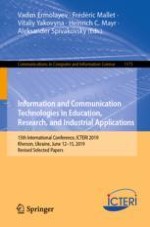2020 | Book
Information and Communication Technologies in Education, Research, and Industrial Applications
15th International Conference, ICTERI 2019, Kherson, Ukraine, June 12–15, 2019, Revised Selected Papers
Editors: Prof. Vadim Ermolayev, Prof. Frédéric Mallet, Vitaliy Yakovyna, Prof. Dr. Heinrich C. Mayr, Aleksander Spivakovsky
Publisher: Springer International Publishing
Book Series : Communications in Computer and Information Science
